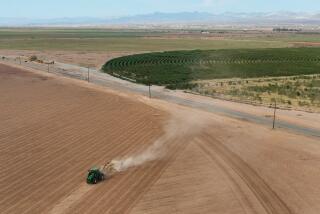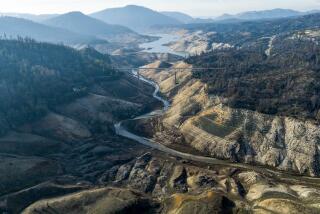La Niña, which worsens hurricanes and drought, is gone

WASHINGTON — After three nasty years, the La Niña weather phenomenon that increases Atlantic hurricane activity and worsens western drought is gone, the National Oceanic and Atmospheric Administration said Thursday.
That’s usually good news for the United States and other parts of the world, including drought-stricken northeast Africa, scientists said.
The globe is now in what’s considered a “neutral” condition and probably trending to an El Niño in late summer or fall, said climate scientist Michelle L’Heureux, head of NOAA’s El Niño/La Niña forecast office.
“It’s over,” said research scientist Azhar Ehsan, who heads Columbia University’s El Niño/La Niña forecasting. “Mother Nature thought to get rid of this one because it’s enough.”
La Niña is a natural and temporary cooling of parts of the Pacific Ocean that changes weather worldwide. In the United States, because La Niña is connected to more Atlantic storms and deeper droughts and wildfires in the West, La Niñas often are more damaging and expensive than their more famous flip side, El Niño, experts said and studies show.
The rare ‘triple dip’ of La Niña was the first time in the 21st century the system appeared three years in a row. Now it could give way to El Niño.
Generally, American agriculture is more damaged by La Niña than El Niño. If the globe jumps into El Niño it means more rain for the Midwestern corn belt and grains in general and could be beneficial, said Michael Ferrari, chief scientific officer of Climate Alpha, a firm that advises investors on financial decisions based on climate.
When there’s a La Niña, there are more storms in the Atlantic during hurricane season because it removes conditions that suppress storm formation. Neutral or El Niño conditions make it harder for storms to get going, but not impossible, scientists said.
Over the last three years, the U.S. has been hit by 14 hurricanes and tropical storms that caused a billion dollars or more in damage, totaling $252 billion in costs, according to NOAA economist and meteorologist Adam Smith. La Niña and people building in harm’s way were factors, he said.
Climate change is a major factor in worsening extreme weather, alongside La Niña, scientists said and numerous studies and reports show. Human-caused warming is like an escalator going up: It makes temperatures increase and extremes worse, while La Niña and El Niño are like jumping up and down on the escalator, according to Northern Illinois University atmospheric sciences professor Victor Gensini.
La Niña has also slightly dampened global average temperatures, keeping warming from breaking annual temperature records, while El Niño slightly turbocharges those temperatures often setting records, scientists said.
La Niña tends to make Western Africa wet, but Eastern Africa, around Somalia, dry. The opposite happens in El Niño with drought-struck Somalia likely to get steady “short rains,” Ehsan said. La Niña has wetter conditions for Indonesia, parts of Australia and the Amazon, but those areas are drier in El Niño, according to NOAA.
The snow-capped Sierra Nevada and the Santa Monica Mountains north of Malibu are among the areas of California no longer considered to be in drought.
El Niño means more heat waves for India and Pakistan and other parts of South Asia and weaker monsoons there, Ehsan said.
This particular La Niña, which started in September 2020 but is considered 3 years old because it affected three different winters, was unusual and one of the longest on record. It took a brief break in 2021 but came roaring back with record intensity.
“I’m sick of this La Niña,” Ehsan said. L’Heureux agreed, saying she’s ready to talk about something else.
The few other times that there’s been a triple-dip La Niña have come after strong El Niños and there’s clear physics on why that happens. But that’s not what happened with this La Niña, L’Heureux said. This one didn’t have a strong El Niño before it.
Even though this La Niña has confounded scientists in the past, they say the signs of it leaving are clear: Water in the key part of the central Pacific warmed to a bit more than the threshold for a La Niña in February, the atmosphere showed some changes and along the eastern Pacific near Peru, there’s already El Niño-like warming brewing on the coast, L’Heureux said.
Think of a La Niña or El Niño as something that pushes the weather system from the Pacific with ripple effects worldwide, L’Heureux said. When there are neutral conditions like now, there’s less push from the Pacific. That means other climatic factors, including the long-term warming trend, have more influence in day-to-day weather, she said.
Without an El Niño or La Niña, forecasters have a harder time predicting seasonal weather trends for summer or fall because the Pacific Ocean has such a big footprint in weeks-long forecasts.
El Niño forecasts made in the spring are generally less reliable than ones made other times of year, so scientists are less sure about what will happen next, L’Heureux said. But NOAA’s forecast said there’s a 60% chance that El Niño will take charge come fall.
There’s also a 5% chance that La Niña will return for an unprecedented fourth dip. L’Heureux said she really doesn’t want that but the scientist in her would find that interesting.
More to Read
Sign up for Essential California
The most important California stories and recommendations in your inbox every morning.
You may occasionally receive promotional content from the Los Angeles Times.












